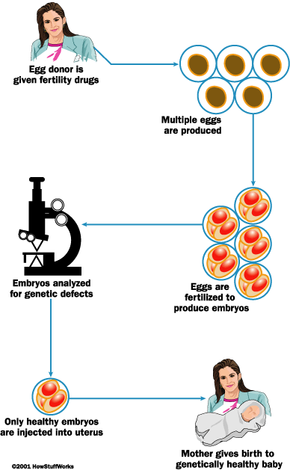Genetic Prescreening
When doctors first performed in vitro fertilization (IVF) in 1978, it gave many otherwise infertile couples a way to have a child of their own. IVF works by removing the eggs from the woman's uterus, fertilizing them in a laboratory and then, a few days later, transferring the fertilized egg, called a zygote, back into the uterus. IVF has also led to a procedure that allows parents to weed out genetically defective embryos. This procedure is called preimplantation genetic diagnosis (PGD).
Advertisement
PGD is often used during IVF to test an embryo for genetic disorders before inserting it into the woman's uterus. Once the egg is fertilized, a cell from each embryo is taken and examined under a microscope for signs of genetic disorders. Many couples use this procedure if there are any inherited disorders in their genes to decrease the possibility that the disorder will passed to their child. Currently, PGD can be used to detect many disorders, including cystic fibrosis, Down syndrome, Tay-Sachs disease and hemophilia A.
Some genetic disorders are specific to one gender or another, such as hemophilia, which usually affects boys. Doctors may examine the cells to determine the gender of the embryo. In a case where a family has a history of hemophilia, only female embryos are selected for placement in the uterus. This practice is at the center of a larger debate about whether parents should be able to choose embryos purely on the basis of gender. Some people worry that it could lead to an imbalance between genders in the general population, especially in societies that favor boys over girls, such as China.
While PGD enables us to pick out embryos that don't have genetic disorders, and even chose the gender we want, it is only the beginning of what genetic engineering can do. Parents could some day custom-order babies with certain traits.
Hair- and eye-color selection is already a (highly controversial) possibility.
